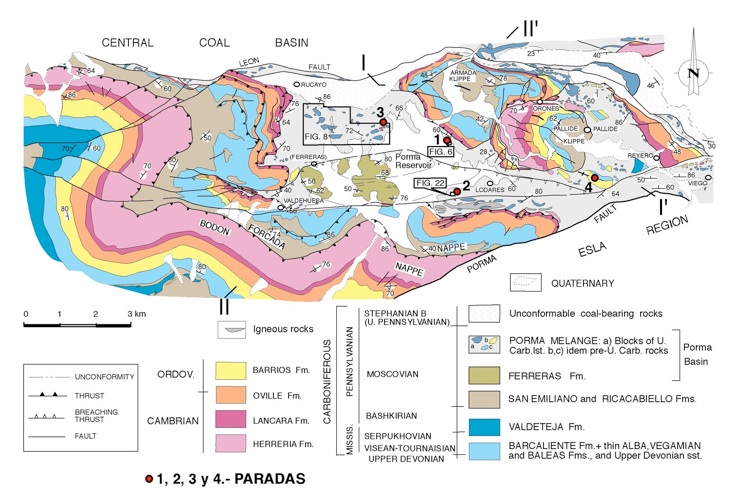Porma melánge

Photo: front of the Forcada Nappe overriding the Porma Melange (Cantabrian Zone)
Fieldtrip leaders: J.L. Alonso, A. Marcos, A. Suárez
Info:
-
J.L. Alonso, A. Marcos, A. Suárez (2006) Structure and organization of the Porma Mélange: progressive denudation of a submarine nappe toe by gravitational collapse. American Journal of Science 306, 32-65.

Geological map of the Porma Melánge and overlying nappes, showing location of the stops
PROCESSES OF STRATAL DISRUPTION IN THE PORMA MÉLANGE
The Porma Mélange is a formation up to 1,5 km thick, underlying a nappe stack and overlying a flysch formation, in the Variscan foreland of the Iberian Peninsula. It is an apparently chaotic mixture of shales and scattered blocks of harder sedimentary rocks. The blocks are extremely diverse in size, from centimetric to kilometric size, and derive from formations ranging in age from Cambrian to Upper Carboniferous.
The Porma Mélange is composed of two different types of rock bodies. Most of the Porma Mélange is a highly deformed, boudinaged sequence of Upper Carboniferous age, with extension values over 300%. This
sequence includes scattered “exotic” blocks, up to kilometric size, with a range of ages from Lower Cambrian to Lower Carboniferous. The boudinaged sequence is the result of bed-parallel extension in two perpendicular directions giving rise to a chocolate tablet structure. The almost complete parallelism between the bedding of equant and elongate boudins suggests a coaxial strain path with the XY plane nearly parallel to the bedding. In the matrix, a bedding-parallel scale cleavage evidences layer-perpendicular shortening. The source of this boudinaged sequence was a semilithified shallow marine succession located at the upper part of the highest nappe. The “exotic” blocks derive from competent well-lithified formations, originally located at the lower part of the nappe stack.
The internal structure and size of the mélange blocks may be related to the degree of lithification of the rocks, since it depends on their age and composition. Greywacke-shale boudins rarely exceed metric scale and display soft-sediment faults in their litharenitic bases that disappear and pass to ductile deformation in the shaly upper part of the beds. Limestone-marl multilayer boudins reach up to hectometric size. Limestone boudins show lesser internal deformation than wacke boudins; their internal faults, if there are any, are in general widely spaced and cut across the whole boudin without noticeable displacement changes recording a more brittle behaviour.
This different behaviour may be attributed to faster lithification of limestone compared with sandstone. Pre-Carboniferous preorogenic sequences provide the biggest blocks, irrespective of whether the rocks are siliciclastic or carbonatic, due to the fact that both of them were well lithified. These blocks are composed, in some cases,
of two or more formations and may display kilometric size.
The different structural features of the Porma Mélange can be explained in terms of the degree of sediment lithification during slumping of a submarine orogenic front. This formation is regarded as the result of stacking of submarine landslides (boudinaged sequence) intercalated with individual slid blocks (exotics). These synorogenic
landslides underwent gravitational spreading during slumping. In the lower part of the boudinaged sequences narrow non-coaxial shear zones have been found, experiencing the highest shear strains, which support the gravitational sliding. The fact that these non-coaxial shear zones have different transport directions is consistent with the flattening strain in the upper part of the sequence. The “exotic” blocks came into the basin as individual slip blocks from competent well-lithified formations, originally located at the lower part of the nappe stack, with higher shear resistance and unable to spread. Statistical distribution of blocks ages in the Porma Basin, where
blocks are progressively older in the nappe transport sense, suggests early collapse of the upper part of the nappe pile and progressive unroofing through subsequent submarine slides. At an early stage of sliding, Pennsylvanian series were the main source of the Porma Mélange; the pre-Carboniferous succession played an increasingly
important role as source of the blocks at later stages.